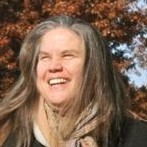DR Folks Volunteer for Maskoke Ecovillage in Alabama: A Dancing Rabbit Update
Published: Tue, 03/29/22

DR Folks Volunteer for Maskoke Ecovillage in Alabama:
A Dancing Rabbit Update
How do you touch a dream, catch smoke, and make a vision into reality? I am currently in that spot, wondering how to describe the experiences I had last week. While I know what I did was simple and humble, my week felt big, expansive and over-the-top. It felt life-changing, exciting, and left me hopeful and optimistic. I haven’t felt that way for a long, long time.
In July, 2014, Dancing Rabbit received a request from a man named Marcus Briggs Cloud to bring a group of Maskoke elders to visit Dancing Rabbit. They were interested in seeing what an ecovillage looked like and wanted to meet some of the people who lived here.
When they arrived after a long drive from Oklahoma it was pouring rain, and we realized that a tour through the mud around the village didn’t make much sense. They had a brief visit with Sharon and Dennis in their house, Robinia, which was still very much just a work-in-progress. The rest of the afternoon was spent in the Milkweed Mercantile in front of the fireplace, drinking coffee and talking.They had questions for Yana (formerly Ma'ikwe and then-executive director of the village nonprofit) about forming a community, as well as lots of questions for the rest of us. Their goal? To acquire some of the land that had traditionally been Maskoke homeland and find a way to preserve their language and culture.
Everything I write seems over the top and hyperbole-filled. I feel like I've drunk the Kool-Aid, been baptized and experienced something life-changing. Perhaps I have. Because they are doing it. Something revolutionary is happening in Weogufka, Alabama: 180 years after being forcibly removed from their traditional homelands, the Maskoke have returned for the purpose of practicing linguistic, cultural and ecological sustainability. It is a quiet, dignified reclaiming of a stolen culture, language, land, family, and a relationship with it all. The group has purchased land that used to belong to their ancestors⎼how many of us know where our great-great-great-grandparents lived? The land is sacred, and the people are deeply rooted. The ecovillage is called Ekvn-Yefolecv (ee-gun yee-full-LEE-juh) which means “returning to our homelands, returning to the earth” and is located just south of Birmingham, Alabama.
This past week, eight folks from Dancing Rabbit and nearby Red Earth Farms went to help where we could, and to continue developing the connection begun seven and a half years ago.
Rutledge, Missouri to Weogufka, Alabama is a 13-hour drive. Somehow, with the right combination of good conversation and junk food (a road trip requirement) we arrived tired, but unscathed. As we approached, we noticed a change in the soil⎼what had been nondescript, boring brown was now red, red, red. We were saddened to see that the acres leading to the village were entirely clear-cut on both sides of the narrow highway. It was pretty depressing⎼the piney woods had been decimated, the trees treated as just another commodity, and the destruction left behind was a stark moonscape.
Once we entered the ecovillage, though, the care being taken with the land was obvious. The buildings that are going up are truly spectacular. They are timber-framed and plastered with a mixture that includes their red soil, with copper-colored roofs that seem to glow in the sunlight. The roads are narrow, rocky, steep and deeply rutted, leftover from when the land was a vacation getaway for its previous owners. There are now bison (not just an animal of the plains), heritage goats and pigs, sturgeon, black Australorp chickens, and a couple of Great Pyrenees dogs. The surrounding forest was originally longleaf pine; remnants still remain and are being encouraged (have you ever seen longleaf pines? They’re amazing! They look like an upside down hula skirt in a fabulous, bright green). As these native pines begin to flourish, it is hoped that the more than 30 endangered species, including red-cockaded woodpeckers and indigo snakes that depend upon longleaf pines, will begin to come back and regenerate, much like the Maskoke people themselves. Gardening is thoughtful, eating is mindful, and all parts of their lives are deeply integrated with spirituality and a sense of belonging on, and to, their land. They are fortunate to still have elders who speak Maskoke (Creek) fluently who are teaching the children. As a result, the children are fluent in Maskoke, as well as English, and they are learning Spanish, too.
Right now there is little time to bask in the beauty of the land and admire what is being built. The plan is ambitious, and the group works seven days a week. Mark, our friend from Red Earth Farms and an accomplished natural builder who has been working on and off there for a number of years, says he has given up telling Marcus that his timeline is impossible. Mark has found that anything that would take a full year in any other situation is somehow being accomplished in a month. There is something to be said for living by one’s principles, reclaiming one’s history, and aspiring to ideals bigger than oneself.
With all of our own work and responsibilities (Dancing Rabbit’s first visitor session begins on April 17th), it seems unlikely that we’ll return before fall. We are also looking forward to having them visit us here, so that we can extend the same warm hospitality that was given to us.
For more information on Ekvn-Yefolecv, visit their website: https://www.ekvn-yefolecv.org/
To learn about Dancing Rabbit’s visitor program visit: https://www.dancingrabbit.org/




